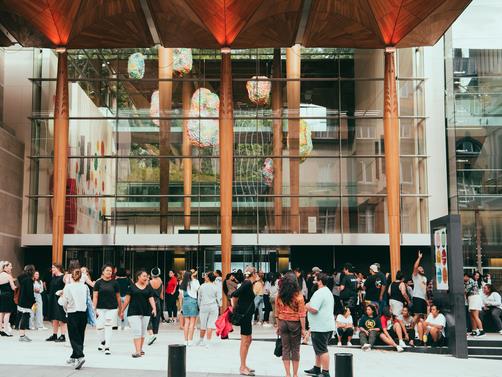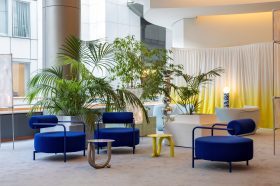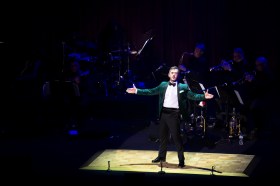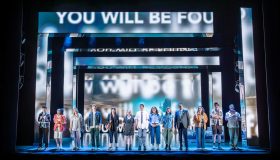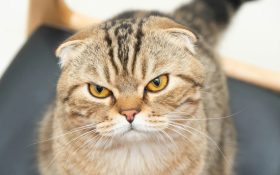Auckland Art Gallery.
It was a significant coup for the Auckland Art Gallery Toi o Tāmaki (AAG) when it appointed the Program Manager for Content Partnerships of New York’s iconic Metropolitan Museum of Art (The Met) late last year.
Neal Stimler joined the New Zealand team as the gallery’s inaugural Head of Public Engagement, after more than a decade with the international giant, and has been tasked with providing greater emphasis on inter-disciplinary public programming, access and outreach initiatives.
As part of this new platform, Stimler will also develop a framework for delivery of an integrated digital experience for audiences throughout the Gallery.
His appointment has been part of a stronger, more sustainable strategy that Gallery Director Rhana Devenport has been working towards over the past five years, and one that received a significant boost this past week with the announcement by Auckland Council that it has committed $NZ20 million to AAG, as part of its 10-year Budget (2018 – 2028).
When ArtsHub spoke with Devenport in March this year she revealed that their then current funding was insufficient to deliver staff salaries and programming.
Read: Auckland’s top gallery director talks tight budgets
What accounts to a NZ$2 million boost per annum, rolling into action with this coming financial year, is welcome news for a gallery that has long punched above its weight.

Neal Stimler. Photo by John McIver. Courtesy Auckland Art Gallery Toi o Tāmaki.
How digital is changing our galleries
Devenport explained: ‘Stimler describes himself as a creative strategist with experience in collaborative leadership, content management, metadata standards, product demonstration, project management, trend forecasting, user training and workflow design.’
ArtsHub caught up with him after six months in the role, and just prior to last week’s funding win. He said: ‘How do I take the resources of our collection and the experience of our exhibitions and connect them to the online audience – it is a very discreet and focused way of using the technology – and that is what I am charged with doing here in Auckland, formulating that strategy for engagement.’
He continued: ‘It’s an important concept, to think about the digital and personal experience of engagement, and I am looking at that closely and how it can become content here at AAG – so if we have a great lecture or public program that will also make its way to the online space for audiences.’
Stimler believes that it is a very blended approach. For example, when a gallery offers a talk in its spaces, it is not always leveraged to its full capacity. ‘We are interested in extending the reach and impact beyond the people who just attend on the night.’
Stimler used the example of a recent event for their Yayoi Kusama exhibition, where 3,000 people attended the program on the day, while 7,000 people watched the event on Facebook Live.
Stimler told ArtsHub: ‘Just as we collect a painting, with our public and learning programs, we want to also collect those experience of art in the gallery and make that more available to people.’
How the digital space can include scholarship
We tend to think of the digital space today as primarily social media channels or heavily branded websites. Stimler believes that there is so much great capacity for connection.
‘I am interested in finding that public intelligent conversation about works of art – that is the tradition I come from and value as a curator, engaging with art history – so keeping part of that at the framework of what we are doing at AAG is part of the picture,’ he said. ‘We want to build a more complex ecosystem of content.’
Before leaving The Met, Stimler worked on the largest open access collection project in the world – digitising some 420,000 objects. While that may have been a different scale to than Auckland’s holdings, Stimler has set equally ambitious goals as the Head of Public Engagement. These were some of the target he hoped for AAG:
- To embrace the importance to experiment, and try to move forward with digital publishing that meets both the academic mind and the public mind. ‘How can I adapt popular technology for a scholarly conversation, that interests me?’ posed Stimler.
- Understanding the digital as your fourth space. ‘I learnt that a lot at The Met. While it is not a physical gallery, it’s your engagement with the world,’ Stimler reminded.
- A hope for a more blended understanding of what “engagement” means. ‘When we digitise our programs – make them digital – we get a whole other layer of metrics and accountability. ‘I am interested for us – the arts in general – to be better at accounting for ourselves, both qualitatively and quantitatively to demonstrate impact,’ said Stimler. ‘It is expected in terms of a cultural conversation at a government level or with philanthropy -–we are looking for those kind of metrics for success.’
- ‘I want to see a passionate and dedicated emphasis on learning in the digital space. So while that may be hard with funding and cultural change, that commitment is really important and it pays off in the long run in terms of building future audiences,’ said Stimler of his primary focus.
He concluded: ‘Digital is not extra and an add on. It is mission critical both in terms of operational reasons how audience find our hours and what is happening, but also as a communication platform for the intellectual and entertainment life of the museum.’
Why leave New York for New Zealand
Stimler revealed to ArtsHub that he had worked in seven different roles over the 12 years that he was at The Met, starting in curatorial and exhibitions.
‘I had reached the breadth of what The Met could offer for me – it was my first job out of undergrad school and I learnt tremendously from colleagues. I was intrigued by the invitation by Rhana; I had met staff from Ta Papa in New York before, and thought it would be a great opportunity, but what really attracted me to New Zealand was that it was positioned with a focus to the Asia Pacific world – and offer a strong pivot for conversation.’
It is a conversation that also includes Australia, and we will be keen observers of AAGs successes under Stimler.
‘I came prepared to learn a lot, and armed with the expertise I have to help apply it strategically here at AAG,’ concluded Stimler.
